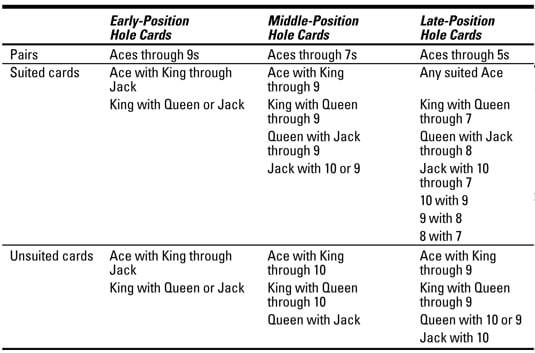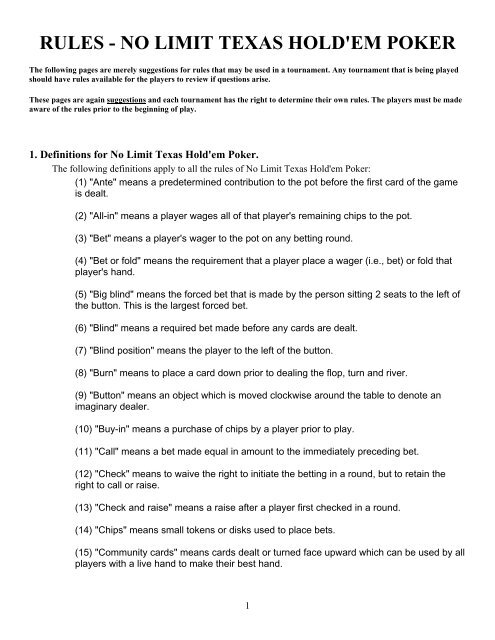Texas Holdem Limit Rules
Texas Hold'em is the most widely played poker variation in the world, particularly thanks to its simple setup and play. This article explains all the rules and concepts you'll need to get started playing it. Hold'em is almost exclusively played with three different betting structures: Limit. In Texas hold'em, if the shown card was any players first hole card, they interrupt the dealing and reshuffles and deal from start. Sometimes, they end the hand if the shown card is the first card of first 4 players. In many games, they won't end the hand.
Mason MalmuthTwo Plus Two Magazine, Vol. 8, No. 12- General Guidelines
- Seven Card Stud
- Limit Texas Hold'em
In Texas hold ’em, a small flat disk, called a “button,” is used to indicate the dealer position. Prior to the cards being dealt, the first player to the left of the dealer position posts a small blind, and the second player to the dealer’s left puts up a big blind, which usually is equal to the first-round bet. Blinds are “live” bets, which signifies two things. First, a blind is a “real” bet, and to enter the pot, a player in a blind position needs only to make up the difference, if any, between his blind and the current bet. Second, players in the blinds have the option of raising when the action gets back to them even if there has been no prior raise. When each hand is completed, the dealer button is moved one position to the left, and the procedure of posting blinds is repeated, so everyone pays his fair share.
To start the hand, each player, beginning with the small blind, receives two cards dealt face down one at a time. Action is initiated on the first betting round by the player to the immediate left of the big blind, who has the options of discarding his hand, calling the big blind, or raising an equivalent amount. The action moves clockwise in this manner until all players have exercised their options and all bets have been called. On all subsequent betting rounds, the first active player to the left of the dealer button starts the action.
After the first round of betting is completed, three cards — referred to as “the flop” — are turned face up simultaneously in the center of the table, and another round of betting occurs. The next two board cards — specified as either fourth street and fifth street or the turn card and the river card — are then dealt face up one at a time in the center of the table, with a betting round after each card. As noted previously, these board cards are community cards and are shared by all active players in the hand.
At the showdown, the player who makes the best five-card poker hand, using any combination of the five cards on board and the two cards in his hand, wins the pot. In Texas hold ’em, more than one player often will have the best hand. When this happens, the pot is split.
Fixed-limit hold ’em games have a two-tiered betting structure, with the lower limit used in the first two betting rounds and the higher limit (which is usually double the lower limit) used in the final two rounds of betting. As an example, suppose you are playing in a $3-$6 hold ’em game. The first player to the left of the dealer position will put in a $1 small blind, and the second player to the dealer’s left will post a $3 big blind. On the first round of betting, the player to the immediate left of the big blind will have the options of discarding his hand, calling the $3 big blind, or raising $3, for a total bet of $6. Subsequent bets and raises both before the flop and on the flop will be in $3 increments. All bets and raises on fourth and fifth streets must be in $6 increments.
Many low-stakes Texas hold ’em games are also played with spread limits which means that any player has the option of betting or raising an amount that is not fixed. For instance, in a typical $1-$4-$8 spread-limit hold ’em game, there will be either two $1 blinds or one $2 blind. The first player to the left of the blind(s) can fold, call the blind, or raise any amount from $1 to $4. Subsequent bets and raises on the first three betting rounds can be from $1 to $4 at the player’s discretion. Bets and raises on the final round of betting can be any amount from $1 to $8.
Many cardrooms throughout the country award jackpots in Texas hold ’em games as well as in seven-card stud games. The procedure used for seeding the jackpot pool and the tips for playing in a hold ’em game that offers a jackpot are the same as those given previously in the section on seven-card stud.
Poker Strategy and Other Topics - November 2019
by Carlos Welch
by Robert Samuels
by Kevin Haney
by Kevin Haney
by Ben Saxton
No Limit Texas Holdem Rules

by Bryan Clark
by Felipe Garcia, CFA and Aaron Byrd, CFA
by Nick Willett
by Mason Malmuth
Texas Hold’em is the world’s most popular form of poker, thanks in large part to the World Series of Poker and other televised poker tournaments that have brought the game to the masses. Texas Hold’em is both easy to play, making it ideal for those just learning about poker, and filled with incredible depth and strategy, making it a game that challenges even professional players. If you need a refresher on the Texas Hold’em Rules, this article should help you get started in this great poker game.
Texas Hold’em Basic Poker Rules
Texas Hold’em is played with a standard deck of 52 cards. The object of the game is to make the best possible five-card poker hand using any combination of the two card’s in a player’s hand (known as the “hole cards”) and the five community cards that the dealer places in the middle of the table, which can be used by all players. The standard hand rankings are used, as follows (from best to worst):

- Straight Flush: Any five cards of the same suit and consecutive rank; the best of these hands, AKQJT of a single suit, is known as a Royal Flush. For these and regular straights, aces may be played as high or low cards.
- Four of a Kind: Any four cards of the same rank.
- Full House: Any three cards from a single rank combined with a pair from a different rank (i.e., TTT55).
- Flush: Any five cards of the same suit.
- Straight: Any five cards of consecutive ranks (i.e., 34567).
- Three of a Kind: Any three cards of the same rank.
- Two Pair: Any two pairs of cards from the same ranks (ie, 5599A).
- One Pair: Any two cards of the same rank.
- High Card: Hands that do not fit any of the above categories are ranked based on the highest card in their hand (aces are high), then by the second highest card, and so on.
Let’s look at these poker hand rankings again visually.
Typically, a game of Texas Hold’em will be played with anywhere from two to ten players at a table. Games with more players are possible, since each player only needs two cards for themselves, but games with more than 11 players at a single table are rare.
Games of Texas Hold’em may be played with many different betting structures. Common ones include Limit Hold’em, where the amount a player may bet is set by the rules of the game, and No Limit Hold’em, where players are free to bet as much of the money they have at the table as they wish at any time. Other structures include Pot Limit Hold’em and Spread Limit Hold’em.
Texas Hold’em Rules: Flow of a Hand
At the beginning of the first hand of play, one player will be assigned the dealer button (in home games, this player will also traditionally act as the dealer for that hand). The player immediately to the left of the button must post the small blind, while the player two seats to the left of the button must post the big blind. The size of these blinds is typically determined by the rules of the game. If any ante is required – common in a tournament situation – players should also contribute it at this point.
Texas Holdem Pot Limit Rules
Once all blinds have been posted and antes have been paid, the dealer will deal two cards to each player. Each player may examine their own cards. The play begins with the player to the left of the big blind. That player may choose to fold, in which case they forfeit their cards and are done with play for that hand. The player may also choose to call the bet, placing an amount of money into the pot equal to the size of the big blind. Finally, the player can also choose to raise, increasing the size of the bet required for other players to stay in the hand.

Moving around the table clockwise, each player may then choose to take any of those options: folding, calling the current bet, or raising the bet. A round of betting ends when all players but one have folded (in which case the one remaining player wins the pot), or when all remaining players have called the current bet. On the first round of betting, if no players raise, the big blind will also have the option to check, essentially passing his turn; this is because the big blind has already placed the current bet amount into the pot, but hasn’t yet had a chance to act.
Assuming there are two or more players remaining in the hand after the first round of betting, the dealer will then deal out three community cards in the middle of the table. These cards are known as the flop. Play now begins, starting with the first player to the left of the dealer button (if every player is still in the hand, this will be the small blind). Players have the same options as before; in addition, if no bet has yet been made in the betting round, players have the option to check. A round of betting can also end if all players check and no bets are made, along with the other ways discussed above.
If two or more players remain in the hand after the second round of betting, the dealer will place a fourth community card – known as the turn – on the table. Once again, a round of betting ensues, using the same rules outlined above. Finally, if two or more players are still around after the third round of betting, the dealer will place the final community card – the river – on the table. One last round of betting will commence.
After this final round of betting, all remaining players must reveal their hands. The player with the best hand according to the hand rankings above will win the pot. If two or more players share the exact same hand, the pot is split evenly between them. After each hand, the button moves one seat to the left, as do the responsibilities of posting the small and big blinds.